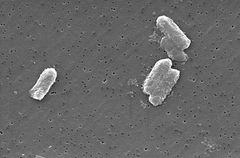Citrobacter freundii
A Microbial Biorealm page on the genus Citrobacter freundii
Classification
Higher order taxa
Bacteria; Proteobacteria; Gammaproteobacteria; Enterobacteriales; Enterobacteriaceae; Citrobacter
Species
|
NCBI: Taxonomy |
Citrobacter Freundii
Description and significance
The Citrobacter species, including Citrobacter freundii, are aerobic gram-negative bacilli. Citrobacter freundii is a long rod-shaped bacteria typically 1-5 μm in length. Most have many flagella used to move about, but a few are non-motile. Its habitat includes the enivronment (soil, water, sewage), food, and the intestinal tracts of animals and humans. It belongs to the family of Enterobacteriaceae.
As an opportunistic pathogen, C.freundii is often the cause of significant opportunistic infections. C. Freundii is known to cause a wide variety of nosocomial infections of the respiratory tract, urinary tract, blood and several other normally sterile sites. It represents approximately 29% of all opportunistic infections. Therefore, one of the main reasons the genome of C. Freundii has been sequenced is in order to find antibiotics that would fight these opportunistic infections.
The Citrobacter genus was discovered in 1932 by Werkman and Gillen. Cultures of C. freundii were isolated and identified in the same year from soil extracts.
Genome structure
Describe the size and content of the genome. How many chromosomes? Circular or linear? Other interesting features? What is known about its sequence? Does it have any plasmids? Are they important to the organism's lifestyle?
Cell structure and metabolism
Describe any interesting features and/or cell structures; how it gains energy; what important molecules it produces.
Ecology
Describe any interactions with other organisms (included eukaryotes), contributions to the environment, effect on environment, etc.
Pathology
How does this organism cause disease? Human, animal, plant hosts? Virulence factors, as well as patient symptoms.
Application to Biotechnology
Does this organism produce any useful compounds or enzymes? What are they and how are they used?
Current Research
Enter summaries of the most recent research here--at least three required
References
Edited by Sumaira Akbarzada, student of Rachel Larsen

